A person’s go-to sales pitch is like a favorite online dating intro message – very personal.
There’s the classic fear of sharing your tried-and-true sales hook and immediately seeing it lose value as everyone else starts copying it.
Sales, just like online dating, is tough.
But we’re here to lend you a hand. Most salespeople keep their good sales pitches and hooks close to their chest, but not at Leadfeeder.
I asked our experts with years of experience in sales to share their favorite hooks, one-liners, full pitches, and go-to terminology they swear by. You’re free to tailor it to your business case, add a personal touch, and enjoy the results.
Let’s start with the nuts and bolts of sales pitches, making our way to the sales secret sauce that wins businesses, sprinkled with Leadfeeder’s best-performing sales pitch examples and templates.
What is a sales pitch?
A sales pitch is the most powerful instrument in your client-generating toolbox, which means it better be sharp.
In short, a sales pitch is a strategically constructed, typically short message that aims to a) introduce your offering to people who will benefit from it and b) make them see its value. It sounds easy, but anyone who has ever written one knows how much sweat it takes.
Sales pitches come in all shapes and forms depending on the medium, specifics of your ICP, and your leads’ stage in the sales cycle.
Key types of sales pitches to master
How you present your sales pitches depends heavily on the channel you use (in-person, phone call, email, social media) and how far down the sales funnel your target audience falls. Plus, a sales pitch can have different “temperatures” — cold, warm, or hot.
Here are the main types of sales pitches you should always have up your sleeve:
Elevator pitch: A brief, 30-second face-to-face pitch that covers the basics of your business, value prop, and mission (why you’re doing it).
Video sales pitch: A pitch delivered in a video format, usually under 3 minutes, that illustrates the benefits of your offering or specific features or educates your prospects on how to use your product.
Follow-up pitch: A second or third reach-out to a lead you didn’t hear back from the first time, designed to elicit a response or action from them.
Cold-calling: A pitch to a lead unfamiliar with your company or offering, delivered by phone.
Email pitch: A sales pitch delivered via email; the most popular type due to its versatile nature.
Social media pitch: A short sales pitch (usually 200-300 characters) of a slightly more personal character, delivered via social networks — for example, a LinkedIn message.
While the content and delivery will vary depending on the type, there are specific components all of them must include to be effective. Can you name them? Here, let me help.
What does a great sales pitch look like?
Before getting all creative with sales pitches, you need to master the basics. Give or take, these are the five ingredients of a killer sales pitch (spoiler: personalization is not one of them):
#1. Problem or pain-point
Newsflash! Every business has problems that need solving.
I mean, aren’t you reading this article because you don’t find your sales tactics efficient? Well, Leadfeeder knows this problem exists, and that’s why I’m writing this article — to help readers like you to solve it.
To hook the person from the get-go, your message (be it a cold email or a demo call) must hit close to home and show that you sympathize with their pain points.
Here’s how you can do that:
Go through your ICP and their challenges.
Research your leads and prospects: scout through their LinkedIn accounts to learn about their job and industry, check what content they post, read the recent news about their company, etc.
Analyze their stage in the sales funnel.
Check the company’s website and social media presence.
This will give you some ideas about the pain points your audience has that your business can solve. And if you’re determined to do it, do it right from start to finish.
#2. Solution
A sales pitch isn’t a Netflix series: you can’t just touch on the person’s pain point and leave on a cliffhanger. You must present them with a solution — your value proposition.
I know this sounds counterintuitive, but in your value prop, don’t list your product’s features. Instead, talk about how it solves the customer’s problem and what benefits they will reap. In other words, focus on how enticing their results could be, thanks to your offering.
Do they have trouble ranking in SERP? Explain how you can get them to rank in the top 1-3. Do they lose dollars due to a convoluted workflow and bureaucracy? Show how your offering can help them save money by automating their documentation.
The more specific your solution is to their business case, the stronger the effect.
#3. Social proof
People might not trust companies (or their sales professionals), but they trust what other people think about them. That’s why 9 out of 10 people will check the product's reviews before buying it. For you, this means that if other people mention your company positively, you can (and should) use it in your sales pitch to build trust.
What social proof you choose and how you deliver it depends on the channel you use. It can be a screenshot of a customer testimonial, a link to a case study, or a mention on social media, i.e., tags in LinkedIn posts or Twitter threads. Additionally, try using implied social proof (“You can achieve X results just like our other client X!”).
#4. Question
In psychology, the person who asks questions controls the conversation. And it’s easy to see why.
First, people usually like to talk about themselves. Second, most of us have a natural urge to answer a question or share our opinion. And finally, questions pull us into dialogue, naturally making us more invested.
When drafting your pitch, consider what questions you can ask the person. Depending on the context, it can be an open-ended or closed-ended question (or both). Sure, we have examples. Read on to see them.
#5. Call to action
The main purpose of your sales pitch is to get a person to do something: to visit your website, book a call, sign up for a free trial, etc. Without it, it’s just a piece of information, not a pitch.
Remember: your leads can’t read your mind. It’s your job to clarify what you want them to do and make it easy for them to do it.
Now, let’s illustrate how all these tips look in practice.
8 Sales pitch examples from Leadfeeder
We’ve rounded up a batch of successful sales pitches we use at Leadfeeder for sales prospecting. These sales pitch examples work like a charm, so you’re in for a treat.
Tailor them to your needs, add some hooks above, or use them as is — that’s up to you.
Example #1: Sales cadence template
Let's start with one of the best. This template is used for top-of-the-funnel sales outreach.
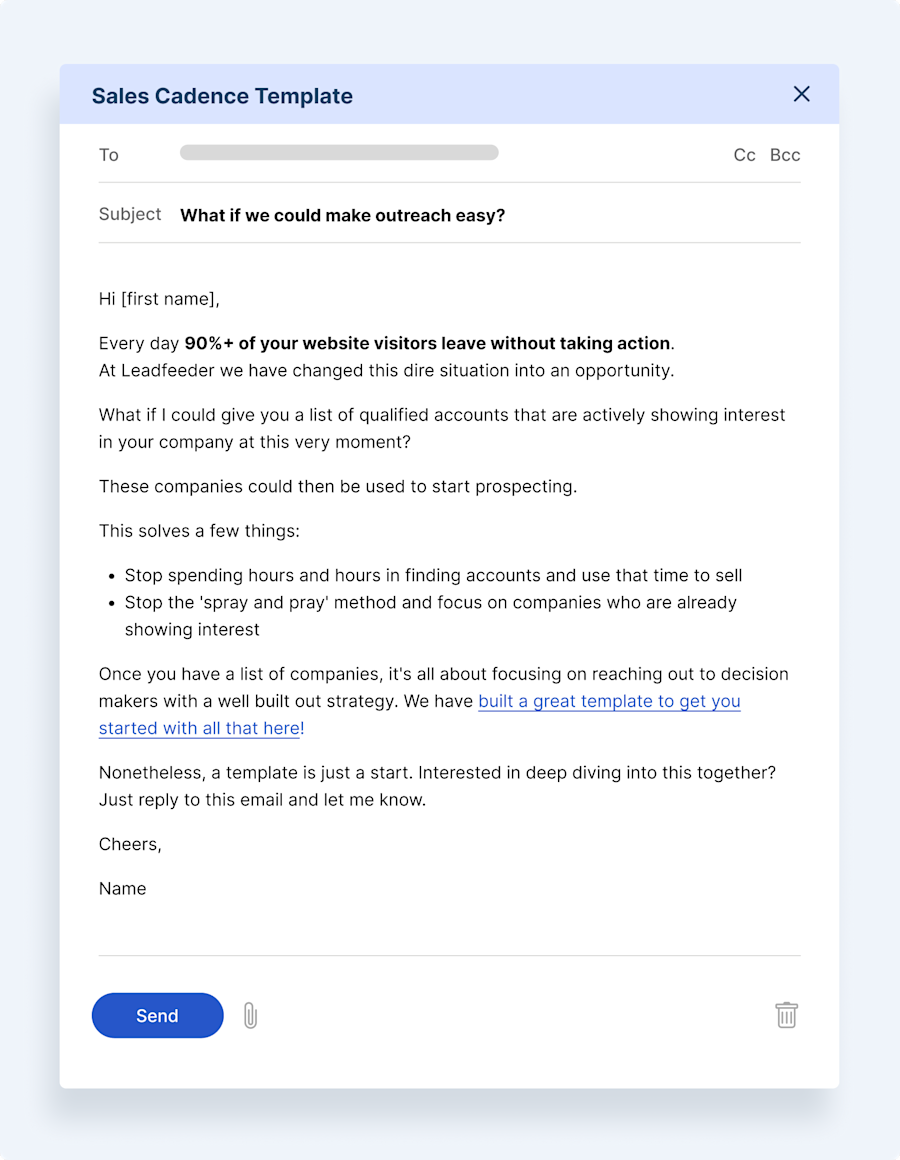
Why it works:
Such a solid opening with the 90 percent stat
Telling the reader what you'll do for them right off the bat
Providing value in your first interaction with the free template
Example #2: Timing in sales and marketing
A good generic sales email for a lead that you don't know much about. This one is relevant to everyone.

Why this works:
Triggering the reader thinking about lost opportunities that Leadfeeder could've helped with
Short and sweet
Clear CTA
Example #3: Retargeting in B2B
Starting out strong with three stats — borrow this template to catch the attention of your prospect right away.
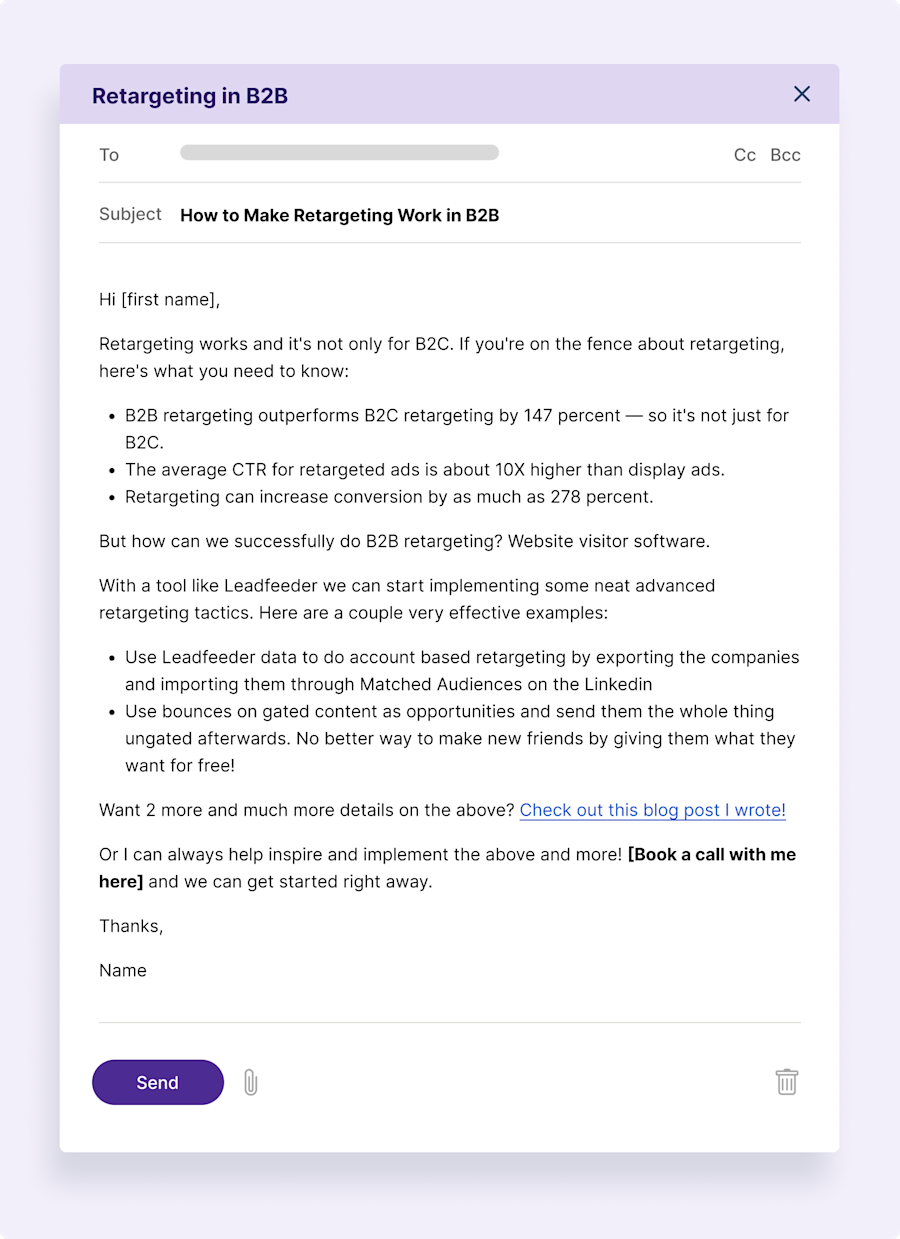
Why this works:
Specific topic (retargeting vs general sales related)
Stat heavy
How Leadfeeder works in retargeting
Example #4: Lead nurturing
The following is one of the emails our sales reps send to those who've visited our product or demo page or signed up for our free trial.
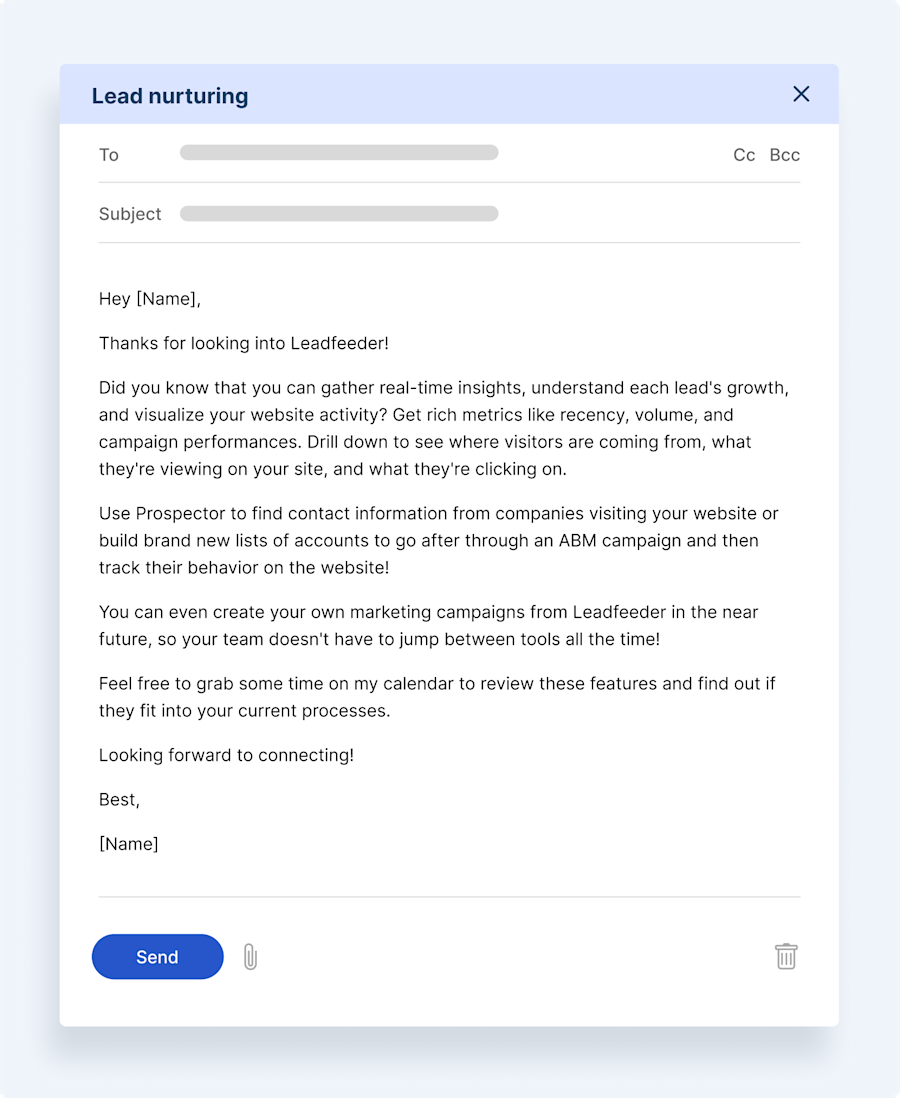
Why it works:
Builds trust from the get-go by thanking the reader
Lists benefits of using the product instead of describing its features
Links our product to the reader’s business goals
Has a clear CTA
Example #5: Follow-up email
Feel free to steal this simple yet mighty sales pitch idea to follow up on your attempted calls with your leads/prospects.

Why it works:
To-the-point
Personalized; shows that we care about the lead and have a solution to their problems
Contains both closed-ended and open-ended questions
Naturally informs about our new tool
Has a clear CTA
Example #6: Prospect nurturing
This message is one of our best sales pitch performers that we send out to educate our free trial users on how to get the most out of Leadfeeder.
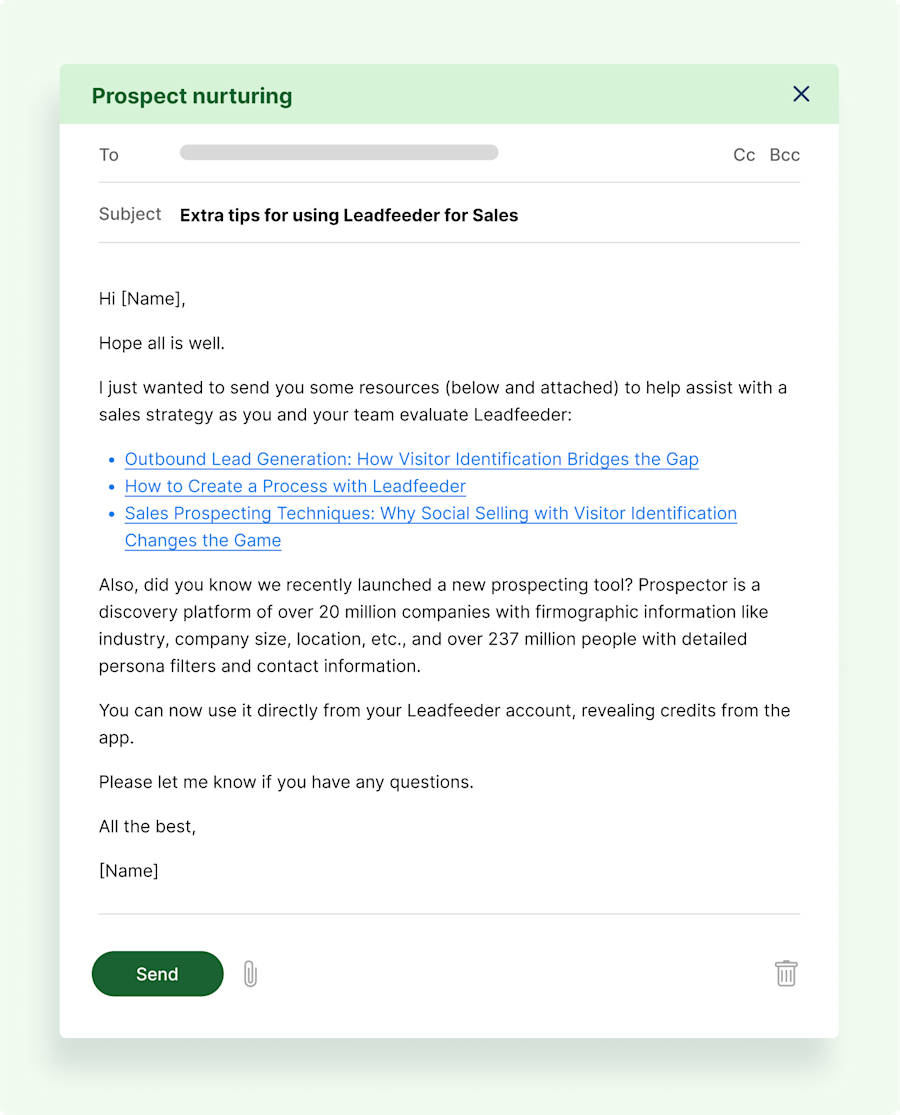
Why it works:
Gets to the point right away
Is personalized — addresses specific needs of this user (sales techniques)
Evokes trust because it addresses the situation and intentions (your team evaluates Leadfeeder, and we want to help you)
Educates and naturally sells our new product in one bottle
Example #7: Cold-pitching
A good example of an effective cold sales message you can use for your email game as well as your LinkedIn outreach hassle.
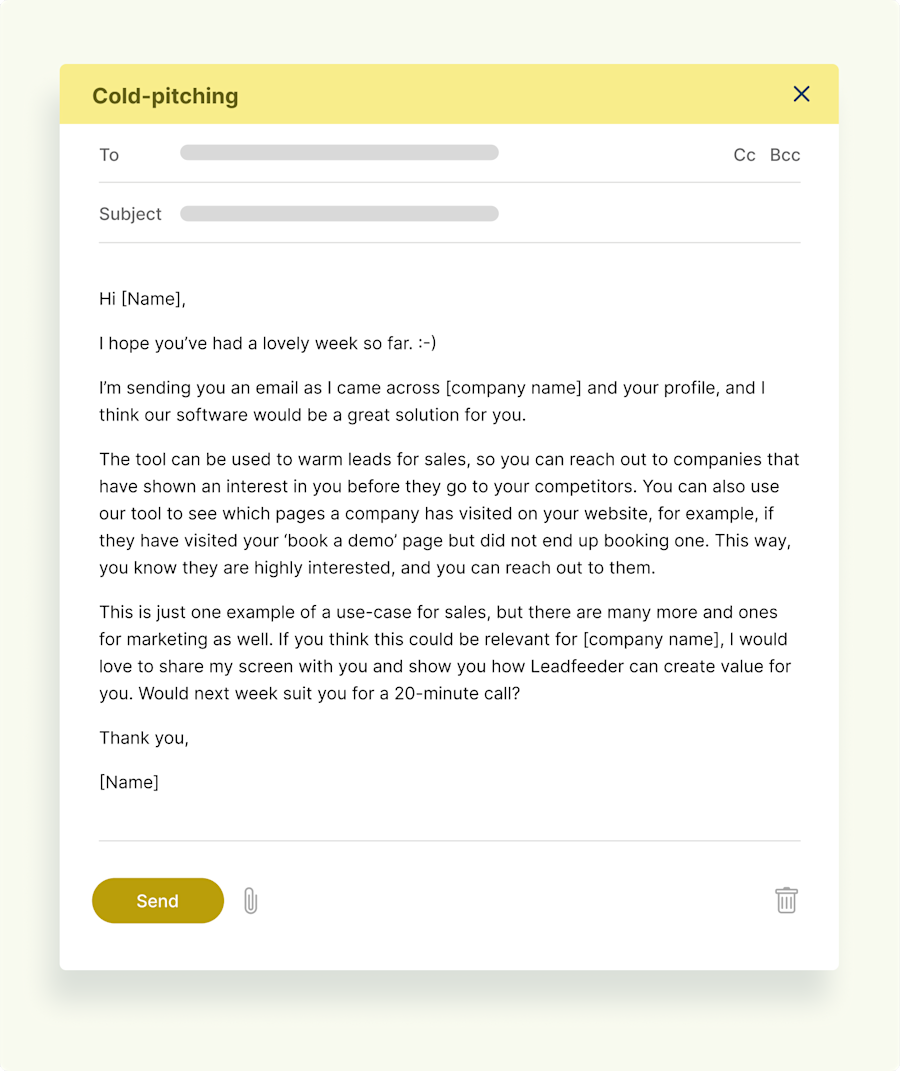
Why it works:
Speaks to the lead’s pain point (I found on their LinkedIn that they had many SDRs, which showed that their use-case could be more sales related)
Promises a solution
Has a clear value proposition and a CTA
Example #8: Video pitch
When you're crafting a text for your sales video, the key is to hook the interest and provide the video with context.
Also, videos are generally used as a more informal medium, so don’t be afraid to loosen up your tone a bit. Our sales team has nailed this witty tone.
Why it works:
Has an intriguing subject line
Is super-personalized: uses the prospect’s name in the video and is dedicated to their specific problem
Is humorous and full of personality
Is short and sweet
Has a clear CTA
5 Tips that will help you write effective sales pitches
These tips will help your sales pitch resonate better with cold leads and prospects alike, as well as handle sales objections.
Understand the potential customer’s needs. This will show that you really did your homework and are serious about solving their problems. Find out what drives the person you’re reaching out to. Do they want to make money or cut spending? Look good in the bosses’ eyes? Get promoted? Scale their business to save time? It can differ from person to person, and your message must speak to it.
Respond quickly. Your hot lead can turn cold faster than you blink. In fact, sales conversions are 391 percent higher in the first minute, with the chances to qualify your lead plunging 80 percent after only five minutes.
Make your subject line catchy (for emails). An average person receives around 121 business emails every day and opens only 50 of them. Your subject line is the difference between the side you fall on in this stat. Keep it short (up to 50 characters), to the point, and leave some intriguing mystery. Generally, when the reader sees your subject line, their thought should be, “Hm, what’s that about?”
Make sure you’re talking to the decision-maker. It will spare you the hassle of going back and forth with people who don’t participate in buying. The easiest way to do this is by using Prospector, a tool that gives you the company name of the people visiting your website and gets the contacts of its decision-makers.
Test your methods. Mastery comes from practice. Try different timing options, play around with the subject or opening lines, tone, body language, and relevance of your offerings. That’s how you know what works best.
Want to write a perfect sales pitch? Know your audience
The better you understand the person on the other end, the better you’ll know how to make your offer resonate with them. This applies to cold-calling, sending follow-ups, connecting on LinkedIn, or pitching face-to-face.
Show that you understand their pains and desires, describe how your solution will help, ask questions to drive the conversation, present some social proof to build trust, and point them in the direction you want them to follow.
And of course, be creative, and confident, respond fast, and make sure you’re talking to the right person.
If you get this right in your own pitch, the conversion will follow.
Now that you're here
Leadfeeder is a tool that shows you companies that visit your website. Leadfeeder generates new leads, offers insight on your customers and can help you increase your marketing ROI.
If you liked this blog post, you'll probably love Leadfeeder, too.
Sign up




